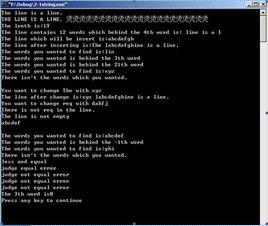例子
已知類String 的原型為:
class String
{
public:
String(const char *str = NULL);// 普通構造函式
String(const String &other); //拷貝構造函式
~ String(void); //析構函式
String & operator =(const String &other);//賦值函式
private:
char *m_data;// 用於保存字元串
};
請編寫String的上述4個函式。
//普通構造函式
String::String(const char *str)
{
if(str==NULL)
{
m_data = new char[1]; // 對空字元串自動申請存放結束標誌'\0'的//加分點:對m_data加NULL 判斷
*m_data = '\0';
}
else
{
int length = strlen(str);
m_data = new char[length+1]; // 若能加 NULL 判斷則更好
strcpy(m_data, str);
}
}
// String的析構函式
String::~String(void)
{
delete[] m_data; // 或delete m_data;
}
//拷貝構造函式
String::String(const String &other) // 輸入參數為const型
{
int length = strlen(other.m_data);
m_data = new char[length+1]; //對m_data加NULL 判斷
strcpy(m_data, other.m_data);
}
//賦值函式
String & String::operator =(const String &other) // 輸入參數為const
型
{
if(this == &other) //檢查自賦值
return *this;
delete[] m_data; //釋放原有的記憶體資源
int length = strlen( other.m_data );
m_data = new char[length+1]; //對m_data加NULL 判斷
strcpy( m_data, other.m_data );
return *this; //返回本對象的引用
}
剖析
能夠準確無誤地編寫出String類的構造函式、拷貝構造函式、賦值函式和析構函式的面試者至少已經具備了C++基本功的60%以上!在這個類中包括了指針類成員變數m_data,當類中包括指針類成員變數時,一定要重載其拷貝構造函式、賦值函式和析構函式,這既是對C++程式設計師的基本要求,也是《Effective C++》中特彆強調的條款。仔細學習這個類,特別注意加注釋的得分點和加分點的意義,這樣就具備了60%以上的C++基本功!

